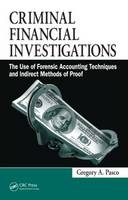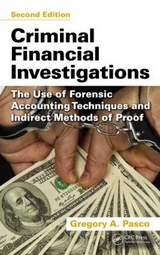
Criminal Financial Investigations
The Use of Forensic Accounting Techniques and Indirect Methods of Proof
Seiten
2008
Crc Press Inc (Verlag)
978-1-4200-9166-3 (ISBN)
Crc Press Inc (Verlag)
978-1-4200-9166-3 (ISBN)
- Titel erscheint in neuer Auflage
- Artikel merken
Zu diesem Artikel existiert eine Nachauflage
Offers instruction on the 'how to' aspects of criminal financial investigations, taking readers through the different approaches used in gathering evidence, and demonstrating how to prepare and present circumstantial evidence to a judge or jury in a simple and convincing manner.
Despite the fact that most crimes are committed for financial gain, little attention is given in forensic literature to the financial motivations behind this criminal behavior. Particularly with white collar crime, understanding these motivations is often the key to the apprehension and successful prosecution of these individuals. Criminal Financial Investigations: The Use of Forensic Accounting Techniques and Indirect Methods of Proof provides direct instruction on the "how to" aspects of criminal financial investigations, taking readers through the different approaches used in gathering evidence, and demonstrating how to prepare and present circumstantial evidence to a judge or jury in a simple and convincing manner.
Proceeding step-by-step through the investigative process, from case initiation to presentation in court, this text presents the relevant legal requirements to successfully establish a case. The author presents a historical overview and examines the different forms of financial fraud and misappropriation of assets, including money laundering and transnational financial transactions. The book defines how the legally accepted indirect methods of proof are constructed and explains how they can establish proof beyond a reasonable doubt. It also outlines the use of search warrants, including the construction of the warrant to ensure that all necessary documentary evidence is collected and corroborated for judicial presentation.
Written by a former Special Agent with the Criminal Investigation Division of the IRS, this volume uses case studies to clarify the material, eschewing a theoretical review in favor of a more "hands on" approach. The book sets out a methodology that provides the foundation for readers to understand what is necessary to identify, pursue, and successfully prosecute financial white collar crime.
Despite the fact that most crimes are committed for financial gain, little attention is given in forensic literature to the financial motivations behind this criminal behavior. Particularly with white collar crime, understanding these motivations is often the key to the apprehension and successful prosecution of these individuals. Criminal Financial Investigations: The Use of Forensic Accounting Techniques and Indirect Methods of Proof provides direct instruction on the "how to" aspects of criminal financial investigations, taking readers through the different approaches used in gathering evidence, and demonstrating how to prepare and present circumstantial evidence to a judge or jury in a simple and convincing manner.
Proceeding step-by-step through the investigative process, from case initiation to presentation in court, this text presents the relevant legal requirements to successfully establish a case. The author presents a historical overview and examines the different forms of financial fraud and misappropriation of assets, including money laundering and transnational financial transactions. The book defines how the legally accepted indirect methods of proof are constructed and explains how they can establish proof beyond a reasonable doubt. It also outlines the use of search warrants, including the construction of the warrant to ensure that all necessary documentary evidence is collected and corroborated for judicial presentation.
Written by a former Special Agent with the Criminal Investigation Division of the IRS, this volume uses case studies to clarify the material, eschewing a theoretical review in favor of a more "hands on" approach. The book sets out a methodology that provides the foundation for readers to understand what is necessary to identify, pursue, and successfully prosecute financial white collar crime.
Colorado Technical University, Sioux Falls, South Dakota, US
Introduction
The Financial Disciplines
Characteristics of Financial Crimes
Categories of Theft
The Paper Trail
Collecting and Preserving Evidence
Gathering Documentary Evidence
Gathering Evidence through Observation
What Is a Financial Investigation?
Requirements for Indirect Methods of Proof
The Standard Methods of Proof
What Processes Are Common to All Indirect Methods of Proof?
The Specific Items Case
The Bank Deposits and Cash Expenditures Case
The Net Worth and Personal Expenditures Case
The Case Report
Preparation for Trial
References
Index
| Erscheint lt. Verlag | 2.12.2008 |
|---|---|
| Zusatzinfo | PPI 500; 9 Illustrations, black and white |
| Verlagsort | Bosa Roca |
| Sprache | englisch |
| Maße | 156 x 234 mm |
| Gewicht | 499 g |
| Themenwelt | Recht / Steuern ► Strafrecht ► Kriminologie |
| ISBN-10 | 1-4200-9166-2 / 1420091662 |
| ISBN-13 | 978-1-4200-9166-3 / 9781420091663 |
| Zustand | Neuware |
| Haben Sie eine Frage zum Produkt? |
Mehr entdecken
aus dem Bereich
aus dem Bereich



